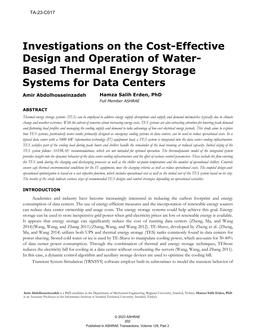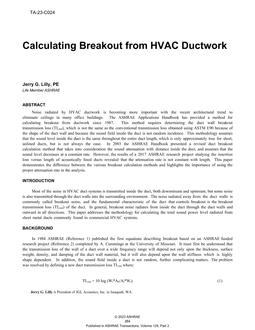-
-
Available Formats
- Options
- Availability
- Priced From ( in USD )
-
Available Formats
-
- Immediate download
- $16.00
- Add to Cart
Customers Who Bought This Also Bought
-

TA-23-C100 – Integrating Building-Scale Solar + Storage +...
Priced From $16.00 -

TA-23-C017 – Investigations on the Cost-Effective Design ...
Priced From $16.00 -

TA-23-C022 – Evaluation of Energy Efficiency and Thermal ...
Priced From $16.00 -

TA-23-C024 – Calculating Breakout from HVAC Ductwork
Priced From $16.00
About This Item
Full Description
Performance-based building energy codes are gaining popularity recently to achieve near future net zero energy and decarbonization targets. The Total System Performance Ratio (TSPR) is a metric for evaluating the overall efficiency of building HVAC systems that can be used to facilitate the implementation of such performance-based approaches. The carbon-based TSPR implemented by the new Washington State Energy Code (WSEC) 2018 is a ratio of the sum of annual heating and cooling loads to the annual carbon emissions associated with the HVAC systems of a building. With limited exceptions, WSEC 2018 implements a unique compliance path by prescriptively requiring certain commercial building types to decouple their space conditioning from outdoor ventilation with specific requirements for space conditioning systems and ventilation systems. These commercial buildings must show a lower simulated HVAC associated carbon emissions than their standard reference design counterparts which also have decoupled space conditioning and ventilation systems. With this unique TSPR compliance requirement taking effect in the state of Washington in 2020 and a similar approach included in the 2022 edition of ASHRAE Standard 90.1, it is important to study and evaluate the current status of its adoption and potential impacts this specific requirement brings. In this paper, we analyze the building characteristics and TSPR evaluation results of more than 200 real-world buildings in the state of Washington, collected through the TSPR web portal, and conduct exploratory data analytics to identify trends, issues, design solutions, additional decarbonization and energy efficiency opportunities. These findings provide insights on what systems and design choices help meet the new performance-based requirements and facilitate decarbonization and net zero energy targets.





